I think I know why. I think it has to do with that can’t teach old dogs new tricks adage. And that’s a barking shame. Because micheladas are one of Mexico’s significant contributions to the world of alcoholic beverages.
Almost everyone is guilty or almost guilty of it. Including me. I’m talking about drinking the same-old same-old, day in, day out. A couple of guys I know only drink red wine. A woman I know only drinks white wine. Quite a few guys only beer. One of them only one brand of beer. Another just rum and cola. I usually drink red wine though perhaps I stray a little more. And there are three occasions when my mind strays to a michelada: When it’s warm and sunny outside. When it’s late morning. And when it’s Sunday (which probably dates back to the hair of the dog days of my youth). On hot, late Sunday mornings, I suppose, there is therefore a probability of the need for three micheladas.
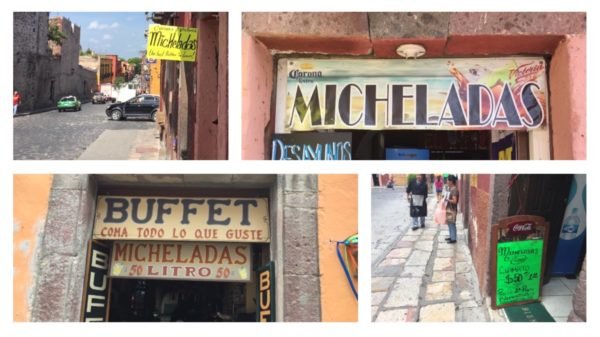
Michelada. It’s a word we constantly see on signs outside San Miguel de Allende bars and restaurants. Or on a chalk board if we venture into one of the cantinas that’s left in town. MICHELADAS. UN LITRO COMPLETO. $50. Micheladas, especially the big and cheap ones, are definitely the biggest lure for locals.
But in the bars I frequent most, a michelada is as rare as a Singapore Sling. And like I said, I think it’s a bit of a shame. Just a bit mind you. I can’t see me ever converting to micheladas as my first choice of beverages.

When and where micheladas were born is a bit of a mystery and, as usual, with the origin of drinks, there are a few different accounts. I’ll give you my favorite two stories, the first because it concerns a city not far from San Miguel de Allende, the second because it’s the most logical.
In San Luis Potosi there’s a fancy tennis and aquatics club called Club Deportivo Potosino and, years ago, there was a regular in the bar of the club called Michel Ésper. Michel liked his beer with lime, salt, ice, and a straw and, in time, other members of the club also started drinking it, asking the bartender for “Michel’s lemonade”.
A considerably more believable etymology (love using that word) is that “chela”, a popular term for beer in Central Mexico, combined with the Spanish words for my and frosty produce the portmanteau (also love using that word) mi chela helada. In fact, though in Central Mexico michelada is the common term, in other parts of the country, chelato is the name of the drink and in Ivy Stark’s Mexican street food book, Dos Caminos, chelato is the only word she uses.
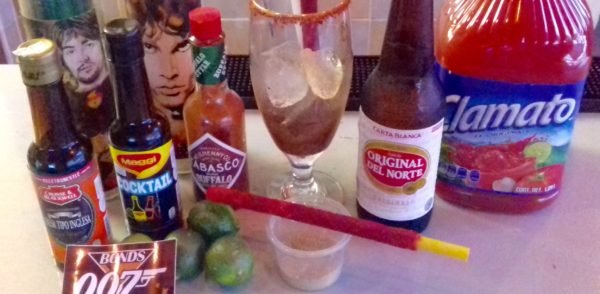
So what exactly goes into a michelada (or a chelato)? Actually, it’s about the most inexact drink there is with almost as many potential ingredients as goes into KFC’s chicken pot pie (which has over 100…and no, I’m not kidding). The five ingredients that I consider essential are beer, clamato or tomato juice, lime, hot sauce and a salted rim. Other ingredients that often find their way into a michelada glass (which should come only in size extra large by the way) are ice, Worcestershire sauce, chamoy powder, orange slices, serrano peppers, Maggi seasoning, pepper (on the rim), chicken bouillon, and horseradish. And, on one occasion each, I’ve seen steak and shrimp.

The beer brand is unimportant and what some guys (but not, of course, me) call the dumb blondes…Indio, Tecate, Corona, Modelo, Pacifico…work perfectly.
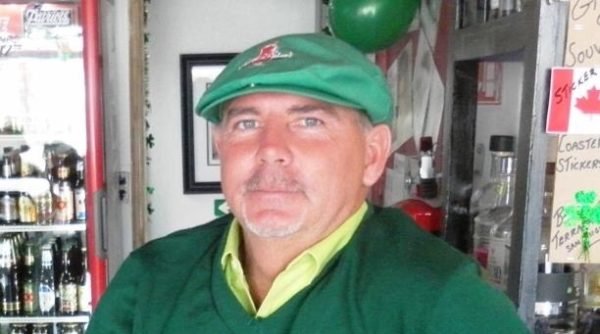
“Never a dark, never a Guinness, but any light beer will do”, Kenny Peters, the proprietor of San Miguel’s Bonds 007 bar told me.
Some recipes call for two bottles of beer and that’s what you’ll get at San Miguel’s La Pamplonada. I think one is plenty if you don’t want your michelada getting warm near the end.
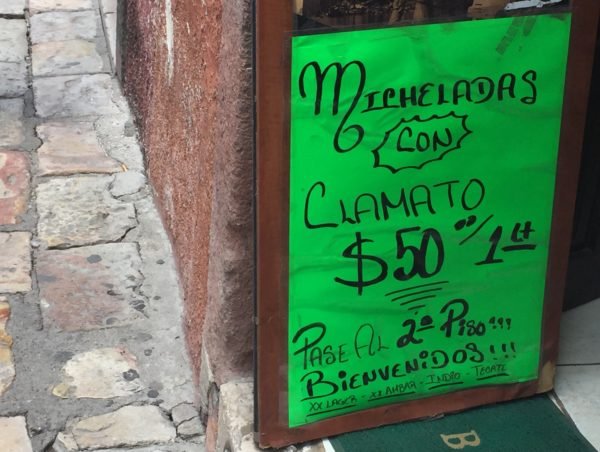
The biggest controversy with regards to ingredients concerns the juice. I say it must be clamato. A lot of other people, particularly Americans, say it must be tomato. Kenny Peters will make it either way but his number one choice is clamato. A lot of it probably has to do with clamato being, like Kenny Peters and Don Day, a Canadian creation and much more important to Canadian ex-pats like Kenny and I than the invention of the combine harvester. “We’ll just have another drink; the wheat will find it’s way into the barn.”

One more thing to be said about clamato is one of its major ingredients. It’s that often maligned MSG that gives clamato its fifth flavor, the one other than salty, sweet, sour or bitter. It’s the magic potion that enhances all of the other flavors in the glass. MSG, however, does give some people the heebie-jeebies, so, for them, tomato juice.
I mentioned that micheladas aren’t that popular in the four San Miguel bars that I frequent. That’s because a sizeable portion of the traffic at Hank’s, Berlin, Bonds 007 and Santo’s are expats and old (back to that new tricks theory I started with). If I have to choose a favorite michelada in town, it’s at Bonds 007. That has something to do with them opening earlier on Sundays and focusing on the seasonal sport on their big screens. The terrace with a view and the ability to be gripping a grilled Polish sausage in your other hand doesn’t hurt either.
I asked Bonds 007 owner Kenny Peters if he would share the “secret” ingredients he uses at Bonds 007 for what he calls the “best summertime refreshing drink” and “great hangover cure”. He said “yes”. They are as follows:
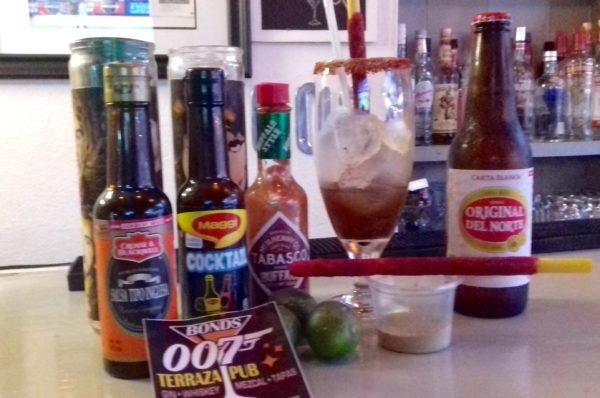
Worcestershire
Maggi cocktail
Buffalo Tobasco
Original cerveza CARTA BLANCA
fresh lime juice
Clamato (or tomato juice upon request)
Pinch of celery salt
Ice
Chilli rimmed glass
Chilli stick
So would I attempt to make it at home now that I know all the ingredients? Never. For I would lose one of the very best reasons to spend time in Mexican bars.

So see you on the terraza at Bonds 007 on some Sunday soon? For your four hundredth michelada or, perhaps, your very first.
Bonds 007 is located at 30 Hidalgo in San Miguel de Allende, Mexico. They are open from Noon on Sundays and on Wednesday through Saturday nights.


There’s a new restaurant upstairs at 28 Hidalgo. Authentic Mexican, using epazote and other old herbs, simple and inexpensive. Worth a visit. Forgot the name.
Thanks. I’ve had a really awful one and have been leery of trying another. Will try Bonds 007 next time. And has to be Clamato!
Thank you for reminding me of this drink…I LOVE it, and will make me a couple tonight….of course with Clamato juice…..
Linda…..
I love Micheladas at La Frontera. I think Noren makes the best I’ve tasted in SMA. Of course, I have not tried Bonds 007.
Micheladas are great but probably the worst drink per my doctor so I ration them. Always with Clamato and always with dark beer as even in micheladas cerveza Blanca doesn’t cut it
BTW the best I’ve had are at Posada de las Mina’s in Pozos
I think that I just added two pounds thinking about micheladas
Hi Don, thanks for your insightful articles and humerous commentary. As a non drinker, I often wondered about the contents and origin of michiladas.
My wife Anita and I first say them being served in Celaya in an out door patio to a group of Mexican office workers having lunch. That was about 20 years ago. As a former restaurant guy, I so appreciate reading about places and the foods in San Miguel. We usually stay for 2 months, February and March and have been visiting since 1996.
Gracias Amido, Mike Sheehan
sorry, I can’t drink micheladas because I don’t care for BEER. However I do like the little red shot of deliciousness that comes with my tequila.
This article is based on the false premise contained in it’s title. In fact, we expats *enjoy* our micheladas greatly….just not in the establishments frequented by the author.
The cause of this misconception? As with all such things, I blame the scourge of the rampaging Canadian masses. God help us all.
We just moved to SMA recently but I have been reading your blog for a year or so. Thanks to this blog post, this old dog just learned a new trick!
Yesterday, I had my first Michelada. Well, actually it was a VickyChelada which is Victoria beer brand michelada in a can. I just happened to see it at a local tienda and, remembering this blog post, decided to give it a try.
I poured some into a pint glass, tasted it and did not gag. Actually, it tasted surprisingly (to me) good. I spiced it up a bit and really enjoyed it! Next, I’ll have to give some of the local concoctions a try.
Gracias! Woof!